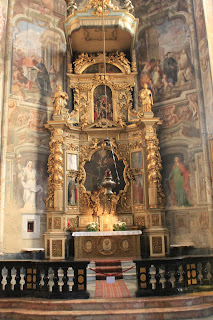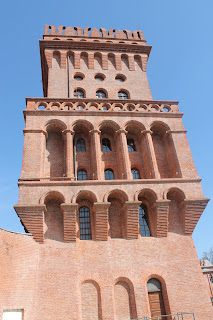Sometimes, only after I write a post or article that attempts to describe a Cathedral, a Church, a Convent or a Monastery, do I realize what a poor job I have done. As I went over this article that I wrote a few days ago, I came to the conclusion that you, our readers and followers, deserve a post that will motivate you tostart a pilgrimage, and visit this church, or one similar to it.
Cattedrale di Santa Maria
Assunta, consecrated by
Pope Urban II, in 1095
on his return from France
where he preached the
First Crusade
I do have a small consolation: most of my fellow writers also do a very poor job of conveying to the reader, the beauty of a Church. However, this consolation is not very consoling.
As we see it today, Santa Maria Assunta is good
example of Piedmont Gothic, built in the early
XIVth Century. Originally it was Romanesque
in style.
One of the great mistakes I usually make is to categorize a church by its architectural style. I do not know who started this nonsense, but it only goes to show how ignorant we writers are, both historically as well as architecturally.
The sides of the Cathedral are reinforced by
buttresses with tall narrow windows, and
polychrome bands created by the contrast of red
bricks and sandstone walls.
La Cattedrale di Maria Assunta di Asti is a good example. When I started to write the "post", I hurriedly put "the Piedmont-Gothic Cathedral" in the title.
The Portico dei Pelletti is the
main entrance on the south side,
built during the 2nd half of the
XVth Century.The Pelletti were
a family of the nobility of Asti.
I am not going to change the title of this post: that is not the point. However, I do want to make something clear to my kind readers. The Cathedral of Asti has been under construction for centuries, specifically since the XIV century. The bell tower is Romanesque. The façade is Piedmont Gothic. The interior decoration is baroque. Do I make my point or shall I go on?
Marble statues of Saints Jerome,
Peter, Paul and Blaise overlook
the entrance at the
Portico dei Pelletti.
Going on a pilgrimage should not be like going out to the country with a net to catch butterflies so that afterwards we can organize the desiccated remains neatly in our walnut and glass display case back home, taking more care to properly classify them by their correct species, rather than to enjoy their beauty.
The Campanile or Bell Tower
was erected in 1266, and is the
only element of the exterior of
the Cathedral that still conserves
the original Romanesque style.
We are more intent at classifying reality, than understanding it. We give terms to things beyond our comprehension. We make constant reference to a series of concepts, usually words that finish with an "ism", instead of reflecting on their meaning.
The greatest accomplishment of this Cathedral is the result of centuries of the devotion of the people of Asti to the Assumption of the Virgin Mary, and the art here contained, portrays that fervor, layer upon layer, generation after generation.
On the north side of the Cattedrale is the Chapel
of Saint Stephen.
The vaults were painted during
the 17th Century with Baroque
motifs.
This chapel is dedicated to the
wedding of the Virgin Mary with
Saint Joseph.
The apse of the Cathedral is
narrow in comparison with the
size of the rest of the church.
The narrowness of the Cathedral
is a result that the architects of
when they enlarged the structure
they tried to respect the original
dimension of the apse, which
tends to make the main altar look
darker than the rest of the
church.
Two organs on both sides of the
main altar were added during the
18th century.
Gilded bronze statue of the
Assumption of Our Blessed
Mother
The octagonal shaped dome of the Cathedral is
very elevated, but does not offer sufficient light
to appreciate the beautiful paintings.
Chapel of the Holy Sacrament,
was decorated with a baroque
altarpiece, and glorifies the
royal lineage of the Blessed
Virgin Mary, while paying
homage to Saint Philip Neri.
This angle gives up a better
perspective of the ceiling of
the side chapel devote to the
Blessed Sacrament, a fine
example of Baroque art in
the Piedmont region.
At the beginning of the
XVIIIth Century, the Cattedrale
underwent a profound interior
decoration with Baroque
paintings on the vaults.
The Niche of the Lamentations over Christ, an
ensemble of terracotta statues from he early1500's
commemorating the sorrow of the Blessed Virgin
and of Saint John at the burial of Jesus Christ,
after His Passion and Death on the Cross.
Baptismal Font (!468) originally
intended for the Church of
Saint John of Asti, but later
was brought over to the chapel
of Saint Stephen at the Cattedrale.
In 1322, one of the original naves of this
Cathedral collapsed, a frequent occurrence
during the middle ages, as prelates and their
architects attempted to make the places of
worship more spacious. This incident
provoked a complete overhaul of the
structure as well as the style of the church.



















































